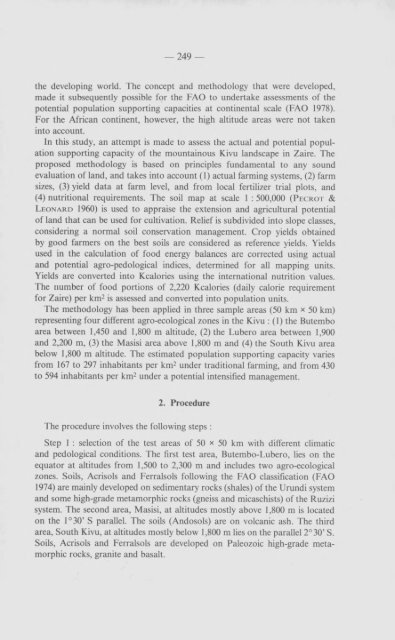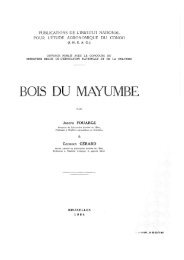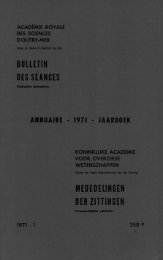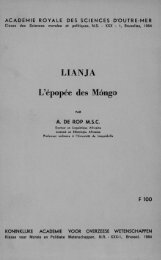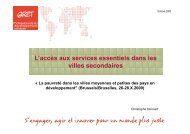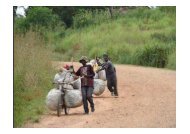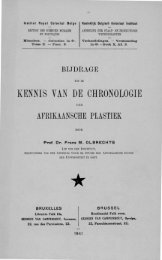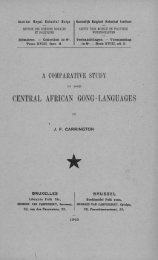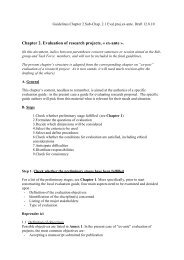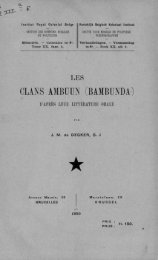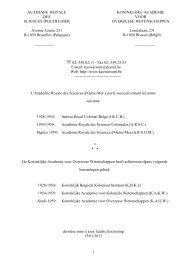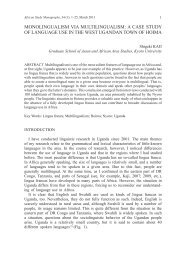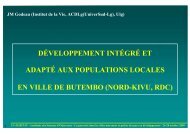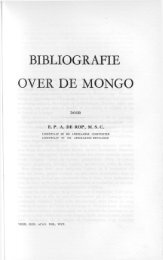mededelingen der zittingen bulletin des seances - Royal Academy ...
mededelingen der zittingen bulletin des seances - Royal Academy ...
mededelingen der zittingen bulletin des seances - Royal Academy ...
Create successful ePaper yourself
Turn your PDF publications into a flip-book with our unique Google optimized e-Paper software.
— 249 —<br />
the developing world. The concept and methodology that were developed,<br />
made it subsequently possible for the FAO to un<strong>der</strong>take assessments of the<br />
potential population supporting capacities at continental scale (FAO 1978).<br />
For the African continent, however, the high altitude areas were not taken<br />
into account.<br />
In this study, an attempt is made to assess the actual and potential population<br />
supporting capacity of the mountainous Kivu landscape in Zaire. The<br />
proposed methodology is based on principles fundamental to any sound<br />
evaluation of land, and takes into account (1) actual farming systems, (2) farm<br />
sizes, (3) yield data at farm level, and from local fertilizer trial plots, and<br />
(4) nutritional requirements. The soil map at scale 1 : 500,000 ( P e c r o t &<br />
L e o n a r d 1960) is used to appraise the extension and agricultural potential<br />
of land that can be used for cultivation. Relief is subdivided into slope classes,<br />
consi<strong>der</strong>ing a normal soil conservation management. Crop yields obtained<br />
by good farmers on the best soils are consi<strong>der</strong>ed as reference yields. Yields<br />
used in the calculation of food energy balances are corrected using actual<br />
and potential agro-pedological indices, determined for all mapping units.<br />
Yields are converted into Kcalories using the international nutrition values.<br />
The number of food portions of 2,220 Kcalories (daily calorie requirement<br />
for Zaire) per km2 is assessed and converted into population units.<br />
The methodology has been applied in three sample areas (50 km x 50 km)<br />
representing four different agro-ecological zones in the Kivu : (1) the Butembo<br />
area between 1,450 and 1,800 m altitude, (2) the Lubero area between 1,900<br />
and 2,200 m, (3) the Masisi area above 1,800 m and (4) the South Kivu area<br />
below 1,800 m altitude. The estimated population supporting capacity varies<br />
from 167 to 297 inhabitants per km2 un<strong>der</strong> traditional farming, and from 430<br />
to 594 inhabitants per km2 un<strong>der</strong> a potential intensified management.<br />
2. Procedure<br />
The procedure involves the following steps :<br />
Step 1 : selection of the test areas of 50 x 50 km with different climatic<br />
and pedological conditions. The first test area, Butembo-Lubero, lies on the<br />
equator at altitu<strong>des</strong> from 1,500 to 2,300 m and inclu<strong>des</strong> two agro-ecological<br />
zones. Soils, Acrisols and Ferralsols following the FAO classification (FAO<br />
1974) are mainly developed on sedimentary rocks (shales) of the Urundi system<br />
and some high-grade metamorphic rocks (gneiss and micaschists) of the Ruzizi<br />
system. The second area, Masisi, at altitu<strong>des</strong> mostly above 1,800 m is located<br />
on the 1°30’ S parallel. The soils (Andosols) are on volcanic ash. The third<br />
area, South Kivu, at altitu<strong>des</strong> mostly below 1,800 m lies on the parallel 2°30’ S.<br />
Soils, Acrisols and Ferralsols are developed on Paleozoic high-grade metamorphic<br />
rocks, granite and basalt.


